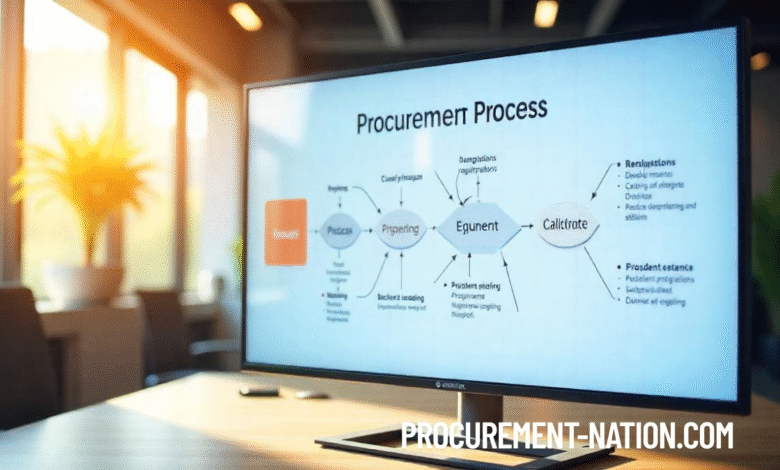ProcurementNation.com Procurement Process A Complete Guide

Procurement plays a pivotal role in the success of any business, ensuring that companies acquire the right goods and services at the best prices. In this comprehensive guide, we will walk you through the essential steps of the Procurementnation.com Procurement Process, highlighting its importance, key components, and best practices for success.
What is Procurement?
Procurement refers to the process of obtaining goods, services, or works from external sources. It plays a vital role in business operations by ensuring that organizations have access to the right resources at the right time. In essence, procurement is about managing relationships with suppliers, negotiating contracts, and ensuring a smooth flow of materials and services needed for production and operations. The procurement process is crucial for minimizing costs, optimizing quality, and meeting deadlines, which are all key to the overall success of a business.
Understanding the Procurement Process
Procurement is a critical aspect of every business, involving the process of obtaining goods and services from external suppliers. Whether it’s raw materials, office supplies, or specialized services, the procurement process ensures that a business runs smoothly. For businesses to succeed, understanding the procurement process is essential. A well-organized procurement process can help reduce costs, ensure the timely delivery of goods, and improve overall efficiency. In this guide, we’ll explore how the Procurementnation.com Procurement Process can streamline your business’s operations and lead to better outcomes.
ProcurementNation.com Procurement Process: Step-by-Step Breakdown
The Procurementnation.com Procurement Process provides a structured approach to purchasing goods and services. Let’s break it down step by step:
Step 1: Identifying Needs
The procurement process begins with identifying what goods or services are required. This could involve consulting different departments within the organization to understand their needs, such as raw materials, software, or even professional services. Clear identification of needs ensures that the right items are purchased, avoiding unnecessary spending.
Step 2: Supplier Sourcing
Once the needs are identified, the next step is finding suppliers who can provide the required goods or services. This may involve researching potential suppliers, requesting quotes, and evaluating their capabilities and reputation. Supplier sourcing ensures that businesses partner with the right vendors who offer quality, reliability, and competitive prices.
Step 3: Request for Proposal (RFP)
A Request for Proposal (RFP) is issued to suppliers to solicit detailed bids for the products or services needed. The RFP outlines the business’s requirements, timeline, and expectations. It allows suppliers to submit their offers, enabling businesses to evaluate different options before making a decision.
Step 4: Negotiating Terms and Agreements
After reviewing the proposals, the next step is negotiating terms and conditions with the selected supplier. This includes pricing, delivery schedules, payment terms, and any other specific conditions. Successful negotiation can result in better deals, ensuring both parties are satisfied with the agreement.
Step 5: Purchase Order and Contracting
Once the terms are agreed upon, a purchase order (PO) is issued to formalize the agreement. The purchase order acts as a binding contract, outlining the specifics of the transaction, such as the products/services, quantity, price, and delivery schedule.
Step 6: Receiving Goods/Services
After the purchase order is accepted, the supplier delivers the goods or services. This step includes inspecting the items to ensure they meet the specified requirements, are of high quality, and are free from defects. Proper receiving ensures that the business gets what it paid for, avoiding discrepancies.
Step 7: Payment and Supplier Evaluation
Finally, payment is made according to the agreed terms, and the supplier’s performance is evaluated. Evaluating suppliers helps maintain long-term relationships and ensures that the procurement process remains smooth. The evaluation includes assessing the quality of goods/services and delivery time.
Key Components of the Procurement Process
The Procurementnation.com Procurement Process encompasses several critical components that businesses need to manage effectively to ensure smooth operations. These include:
- Supplier Relationship Management: Building and maintaining strong relationships with suppliers is key to ensuring timely deliveries, consistent quality, and favorable terms.
- Sourcing: Identifying and selecting suppliers is a crucial step in procurement. It involves conducting market research, vetting suppliers, and selecting the best match for the business’s needs.
- Contracts: Properly written contracts protect both parties, outlining terms, conditions, and responsibilities.
- Payment Processes: Efficient payment systems ensure that suppliers are paid on time, fostering good relationships and maintaining a reliable supply chain.
The Role of Technology in Modern Procurement
Technology has drastically transformed the procurement process. Tools like procurement software, automation, and eProcurement platforms like Procurementnation.com are making procurement faster, more accurate, and cost-effective. These tools help businesses:
- Automate repetitive tasks, such as order creation and supplier communication.
- Track orders and inventory in real-time.
- Simplify the approval and payment processes.
- Reduce errors and improve compliance.
These advancements help companies streamline their operations, reduce costs, and gain better control over their procurement activities.
Best Practices for Efficient Procurement
To optimize the Procurementnation.com Procurement Process, businesses should adopt best practices, such as:
- Strategic Sourcing: This involves identifying and choosing suppliers that offer the best value, not just the lowest price.
- Clear Communication: Open and transparent communication with suppliers helps avoid misunderstandings and ensures smooth transactions.
- Automation: Using procurement software and automation tools like Procurementnation.com can help reduce manual tasks, speed up the process, and minimize errors.
- Regular Supplier Evaluation: Consistently evaluating suppliers ensures you are working with the best, most reliable partners.
- Cost Monitoring: Keep track of procurement costs to identify potential savings and make better purchasing decisions.
How Procurementnation.com Facilitates the Procurement Process
Procurementnation.com offers businesses a comprehensive platform to manage the entire procurement process, from supplier sourcing to payment. Key features include:
- Supplier Marketplace: Businesses can easily find and compare suppliers within the platform.
- RFP Management: Simplifies the creation, distribution, and evaluation of RFPs.
- Automated Purchase Orders: Automates the creation of purchase orders based on RFP responses.
- Supplier Performance Tracking: Keeps track of supplier performance for future evaluations.
These features help businesses streamline procurement tasks, reduce administrative burdens, and ensure smoother transactions.
Common Challenges in the Procurement Process and How to Overcome Them
Despite its importance, the procurement process can come with challenges. Some common issues include:
- Poor Supplier Communication: Misunderstandings can lead to delays, incorrect orders, or quality issues. Overcome this by maintaining clear and open lines of communication with suppliers.
- Budget Overruns: Procurement processes can sometimes lead to unplanned expenses. To avoid this, establish a clear budget and stick to it, using tools like Procurementnation.com to track expenses.
- Lack of Visibility: Without real-time tracking, businesses may struggle to manage orders efficiently. Implementing procurement software ensures full visibility over the entire procurement cycle.
How to Select the Right Procurement Solution for Your Business
When choosing a procurement solution like Procurementnation.com, businesses should consider factors such as:
- Scalability: Ensure the solution can grow with your business and handle increasing procurement needs.
- Ease of Use: Look for a user-friendly platform that simplifies the procurement process for all team members.
- Cost-effectiveness: Compare pricing and features to ensure you get the best value for your investment.
Conclusion: Optimizing Your Procurement for Business Success
A well-organized procurement process is crucial for the success of any business. By optimizing the Procurementnation.com Procurement Process, businesses can reduce costs, enhance supplier relationships, and streamline their purchasing activities. The use of technology and best practices ensures that the procurement process remains efficient, effective, and adaptable to future growth.
Frequently Asked Questions About Procurementnation.com Procurement Process
What is the procurement process on Procurementnation.com?
The procurement process on Procurementnation.com follows a structured cycle, including supplier sourcing, RFP management, contract negotiation, purchase order creation, and supplier evaluation.
How does Procurementnation.com help businesses save costs?
By automating repetitive tasks, offering a supplier marketplace, and providing data-driven insights, Procurementnation.com helps businesses reduce procurement costs.
Can Procurementnation.com integrate with existing business systems?
Yes, Procurementnation.com offers integration with various ERP and financial systems, streamlining procurement across platforms.
Is Procurementnation.com suitable for businesses of all sizes?
Yes, the platform is scalable and designed to meet the needs of businesses, whether small or large.




2 Comments